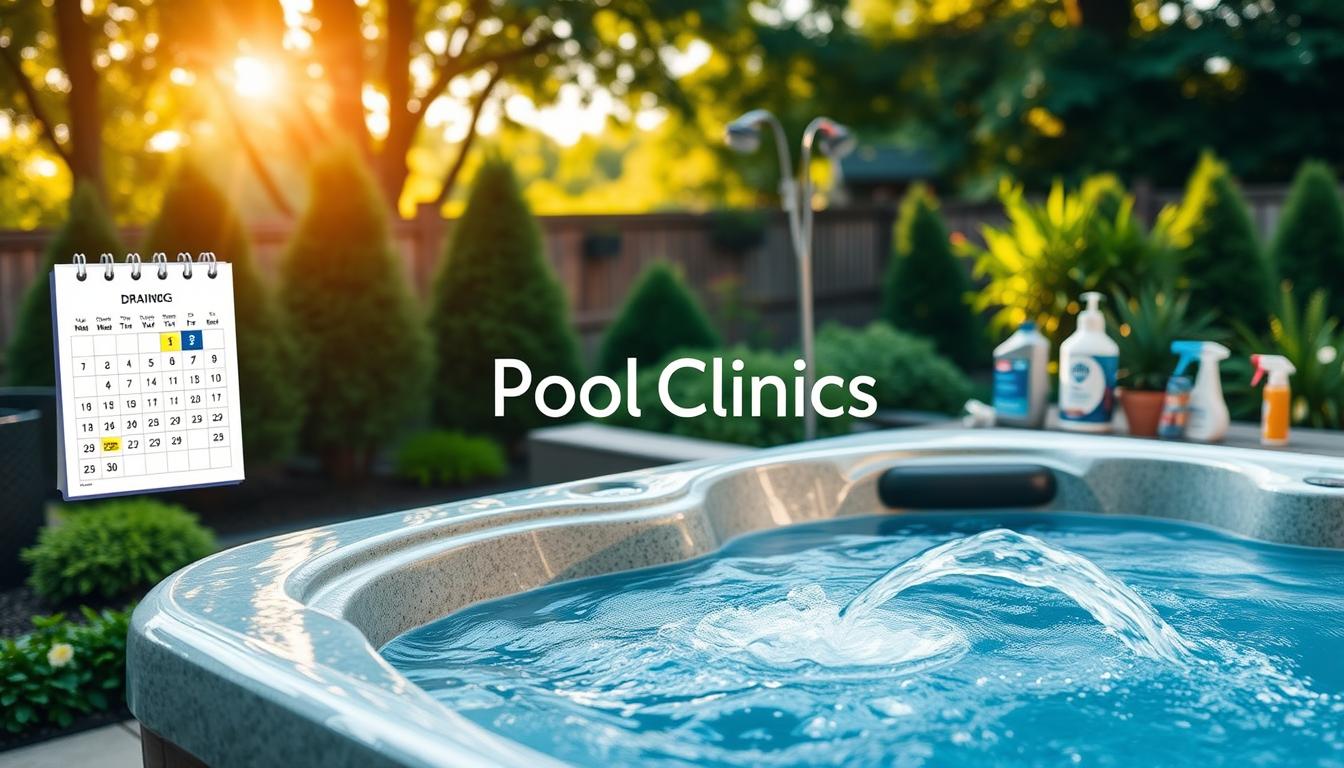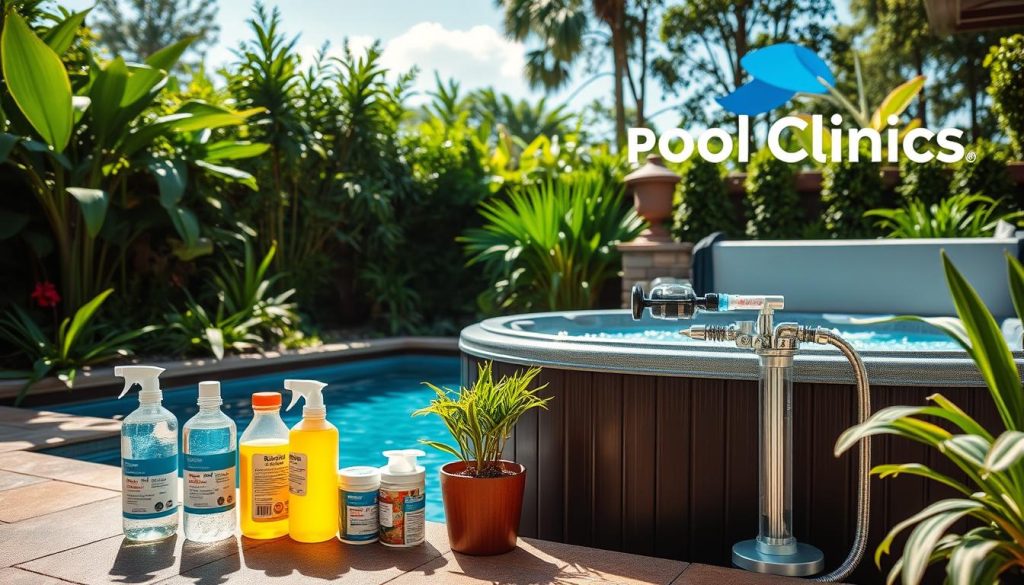
Hot tubs offer a blissful escape after a long day. They’re a sanctuary for relaxation and quality time. But to keep this oasis pristine, proper maintenance is key.
Draining and refilling your hot tub regularly ensures clean, safe soaks. Many owners wonder about the right timing for this task. Let’s explore the factors that influence draining frequency.
Key Takeaways
- Drain and clean your hot tub every three to four months, on average
- Factors like usage frequency, number of users, and water quality impact draining intervals
- Test total dissolved solids (TDS) levels to determine when to drain your hot tub
- Proper draining, cleaning, and refilling are crucial for maintaining a clean and safe hot tub
- Establishing a consistent hot tub maintenance schedule ensures optimal performance and longevity
Factors Affecting Hot Tub Draining Frequency
Understanding when to drain your hot tub is vital for a safe experience. Proper draining routines help extend water life and keep the environment healthy. Let’s explore key factors that affect water replacement guidelines.

Frequency of Hot Tub Usage
How often you use your hot tub affects draining frequency. Heavy use (2-3 times weekly) needs a water change every 4-6 weeks. Moderate use (1-2 times weekly) requires changes every 2-3 months.
Light use (less than once weekly) allows changes every 3-4 months. Adjust your draining schedule based on usage to maintain good water quality.
Number of Users
More users mean more contaminants like sweat, lotions, and oils in the water. This leads to faster buildup of dissolved solids and organic matter. As a result, you’ll need to drain the hot tub more often.
Water Quality and Chemical Balance
Proper water chemistry is crucial for hot tub longevity and user health. Ideal pH levels range from 7.2 to 7.8, with alkalinity between 80 and 120 ppm.
Imbalanced levels can cause skin irritation, corrosion, and reduced sanitizer effectiveness. Factors affecting pH include water quality, usage, users, treatment products, and environment.
| pH Level | Effects | Corrective Measures |
|---|---|---|
| Above 7.8 | Skin and eye irritation, reduced sanitizer effectiveness | pH decreaser |
| Below 7.2 | Corrosion, skin irritation | pH increaser |
Signs of pH imbalance include cloudy water, foam, foul smell, and scale or corrosion. If balancing chemicals is difficult, it’s time to drain and refill.
Regular monitoring and adjusting of chemical levels can extend your hot tub water’s life. This ensures a safe and enjoyable experience for all users.
Signs Indicating It’s Time to Drain Your Hot Tub
Keeping spa water clean and safe is crucial for hot tub owners. Several signs show when it’s time to change the water. Recognizing these indicators helps maintain optimal water quality and prevent future issues.
Foul Odors
A strong, unpleasant smell from the water is a clear sign to drain your hot tub. This odor often results from a buildup of sweat, body oils, and bacteria. It’s time to change the water and clean your spa thoroughly.
Cloudy or Discolored Water
Murky, greenish, or brownish water indicates water quality issues. This can be caused by high total dissolved solids, improper pH balance, or contaminants. Cloudy water is a strong signal that your hot tub needs draining.
Buildup of Foam
Excessive foam on the water surface means it’s time for a change. This buildup often comes from oils, lotions, and organic matter. If foam persists despite using anti-foaming agents, drain and refill your hot tub.
Persistent Water Imbalance
Constant struggles with water chemistry suggest it’s time to drain. This can happen when there’s a high concentration of dissolved solids or contaminants. It makes it hard to keep pH, alkalinity, and sanitizer levels in check.
Visible Debris and Sediment
Debris like leaves, dirt, and small particles can accumulate over time. If you see floating debris or sediment at the bottom, it’s time for a water change. This buildup affects both appearance and water quality.
Difficulty Maintaining Chemical Levels
Rapid sanitizer depletion or unstable chemical levels signal the need to drain. High contaminant levels can quickly use up chlorine or bromine. This makes it hard to keep the water properly disinfected and safe.
| Indicator | Cause | Solution |
|---|---|---|
| Foul odors | Buildup of contaminants (sweat, oils, bacteria) | Drain, clean, and refill the hot tub |
| Cloudy or discolored water | High TDS, improper pH, algae, or contaminants | Test water, adjust chemistry, or drain and refill |
| Excessive foam buildup | Accumulation of oils, lotions, and organic matter | Use anti-foaming agents, or drain and refill |
| Persistent water imbalance | High concentration of dissolved solids or contaminants | Drain, clean, and refill the hot tub |
| Visible debris and sediment | Accumulation of leaves, dirt, and small particles | Remove debris, drain, clean, and refill the hot tub |
| Difficulty maintaining chemical levels | High levels of contaminants depleting sanitizer | Shock the water, or drain and refill the hot tub |
Watching for these signs helps ensure clean, safe, and enjoyable spa water. Regular upkeep and timely water changes extend your hot tub’s life. This approach provides a relaxing, worry-free experience for all users.
How Often to Drain Hot Tub: Expert Recommendations
Experts suggest draining and cleaning your hot tub every 3 to 4 months. This keeps the water safe and enjoyable for all users. However, this timeline may change based on usage and number of users.
Heavy use might require more frequent draining. Large gatherings or big families can lead to faster buildup of contaminants. In these cases, you’ll need to clean more often to maintain water quality.
Pay attention to signs that indicate it’s time for a drain and refill. These include foul odors, cloudy water, and excessive foam. Difficulty balancing chemicals and visible debris are also warning signs.
- Foul odors emanating from the water
- Cloudy or discolored water
- Excessive foam buildup
- Difficulty maintaining proper chemical balance
- Visible debris and sediment accumulation
Follow the manufacturer’s guidelines when draining your hot tub. Use appropriate cleaning products for best results. When refilling, experts recommend adding specific products to maintain water quality.
| Product | Amount | Purpose |
|---|---|---|
| Fresh Start | 1 full bottle per refill | Helps establish proper water chemistry |
| SpaGuard Chlorinating Concentrate | 1/2 teaspoon per 100 gallons | Provides initial chlorine boost |
Remember, regular maintenance practices, such as cleaning filters and maintaining proper chemical balance, can help extend the time between drainings and keep our hot tub in top shape.
Stick to the recommended hot tub draining schedule for optimal performance. Follow expert hot tub draining advice to ensure longevity. This will provide a safe and enjoyable experience for all users.
Conclusion
Keeping hot tub water clean is crucial for a safe, fun experience. Usage, number of users, and water chemistry affect draining frequency. Experts suggest draining and refilling every 3-4 months, adjusting for use levels.
Watch for signs like foul odors, cloudy water, and foam buildup. These indicate it’s time to drain. Clean the shell, jets, and filters thoroughly during each water change.
Test and balance pH, alkalinity, and sanitizer levels regularly. Proper plumbing maintenance is also key. This comprehensive care routine ensures a clean, inviting environment.
Regular draining and refilling based on expert advice helps maximize your hot tub’s lifespan. It also ensures optimal water quality. By following these steps, you’ll create a safe, healthy space for relaxation.







